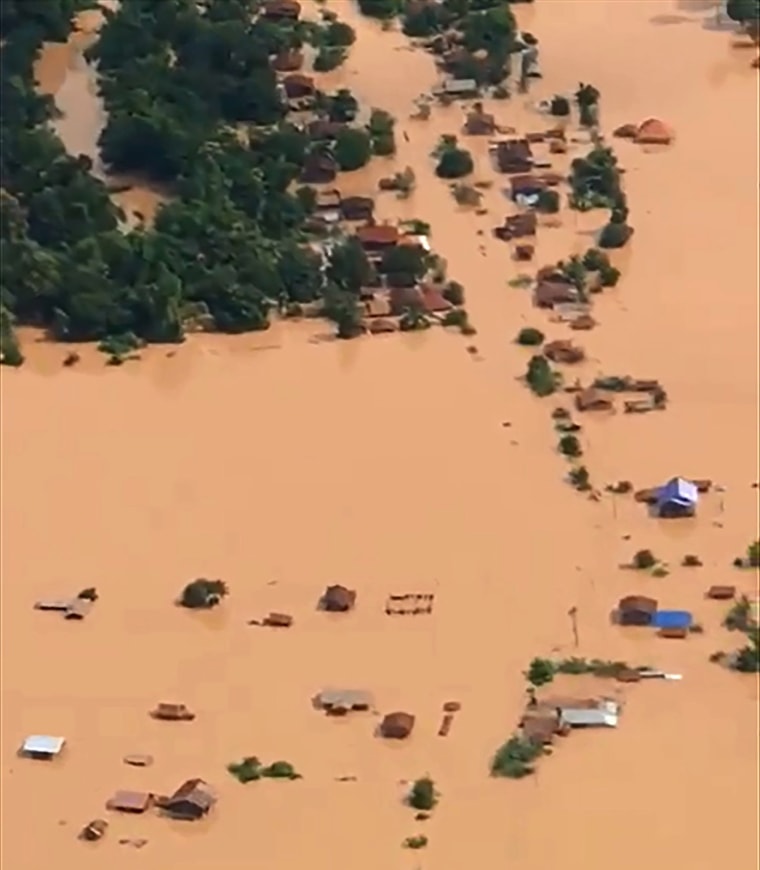BANGKOK — Massive flooding from a South Korean-constructed hydroelectric dam in Laos left several people dead and hundreds missing, state media said Tuesday. Rescue efforts were underway as top government officials rushed to the site and public appeals were launched for aid.
The official KPL news agency reported Tuesday that the Xepian-Xe Nam Noy hydropower dam in Attapeu province collapsed Monday night, releasing large amounts of water and sweeping away houses, leaving more than more than 6,600 people homeless.

A later report on the website of the state-run Vientiane Times newspaper, however, said water had overflowed the dam, rather than bursting it. It said the dam was at risk of collapse, and rain and strong winds predicted for the next few days could make the situation worse.
It said two people were confirmed dead by Tuesday afternoon from flash floods that affected eight villages, and that the government had declared the flooded area an emergency disaster zone.
KPL said the disaster "claimed several human lives" and "left hundreds of people missing," without providing details.
Photos and videos posted on social media showed people sitting on rooftops to escape the surging water, while others were carried to safety or rescued by boat. State media said helicopters were also being used to rescue people.
The dam was constructed by a joint venture led by South Korean companies, with Thai and Lao partners. It was scheduled to open this year, but it was unclear if it had begun operating.
KPL described the portion that collapsed as a "saddle dam," which is an auxiliary dam used to hold water beyond what is held by the main dam.
South Korea's Yonhap News agency quoted an unidentified official at SK Engineering & Construction, one of the two South Korean partners in the project, as saying rain in the area was triple the usual amount, and one of five auxiliary dams had overflowed.
Many areas of Laos have recently been hit by floods from heavy seasonal rains.
Prime Minister Thongloun Sisoulith suspended his government's planned Cabinet meeting and traveled with fellow ministers and other senior officials to Sanamxay district to monitor rescue and relief efforts, KPL and the Vientiane Times reported.
Provincial authorities issued a call for emergency aid — clothing, food, drinking water, medicine, cash and other items — from the "party, government organizations, business community, officials, police and military forces and people of all strata."

Laos is one of the poorest countries in Asia. It has transitioned from communism to a market economy but remains a single-party state where freedoms are limited. There is virtually no freedom of the press, and foreign reporters who visit operate under tight restrictions, limiting the flow of information.
Electricity from several hydroelectric dams provides a large share of Laos' export earnings, with Thailand being a major buyer.
KPL said the Xepian-Xe Nam Noy project cost an estimated $1.02 billion. Much of the financing came from Thai lenders.
According to the website of the company that built and runs the dam, it is majority-owned by SK E&C and Korea Western Power. The Ratchaburi Electricity Generating Holding Public Co. Ltd. of Thailand holds a 25 percent stake and the Lao Holding State Enterprise holds 24 percent.
The dam was built to divert the Houay Makchanh, Xe-Namnoy and Xe-Pian rivers into reservoirs that feed into a 410-megawatt power plant that is due to begin operations in 2019. Only 10 percent of the power generated was to be used locally, with 90 percent exported to Thailand.
Laos is supposed to receive taxes, royalties and other income estimated at $33 billion per year from the dam.
According to project assessment documents, about 30 villages were affected by the project with more than 2,000 people in eight villages resettled. Roughly 10,000 people live in the affected area, with most belonging to ethnic minorities.